Analysis of Concentrated Solar Power (CSP) in Australia: Technology
VerifiedAdded on 2023/03/23
|24
|6788
|96
Report
AI Summary
This report provides a comprehensive analysis of Concentrated Solar Power (CSP) in Australia, examining the current state of the technology, its environmental and economic impacts, and technical developments. It delves into various CSP technologies, including parabolic troughs, solar power towers, enclosed troughs, Fresnel reflectors, and dish stirling systems, highlighting their functionalities and applications. The report explores the advantages of CSP, such as reduced reliance on conventional fuels and lower carbon emissions, while also addressing challenges like water availability, visual effects, and capital costs. Furthermore, it discusses future technological advancements, potential sites, and barriers to adoption, offering a balanced perspective on CSP's role in Australia's energy landscape. The report also considers the impact of CSP on wildlife and employment, and concludes with a personal opinion on the technology's prospects.
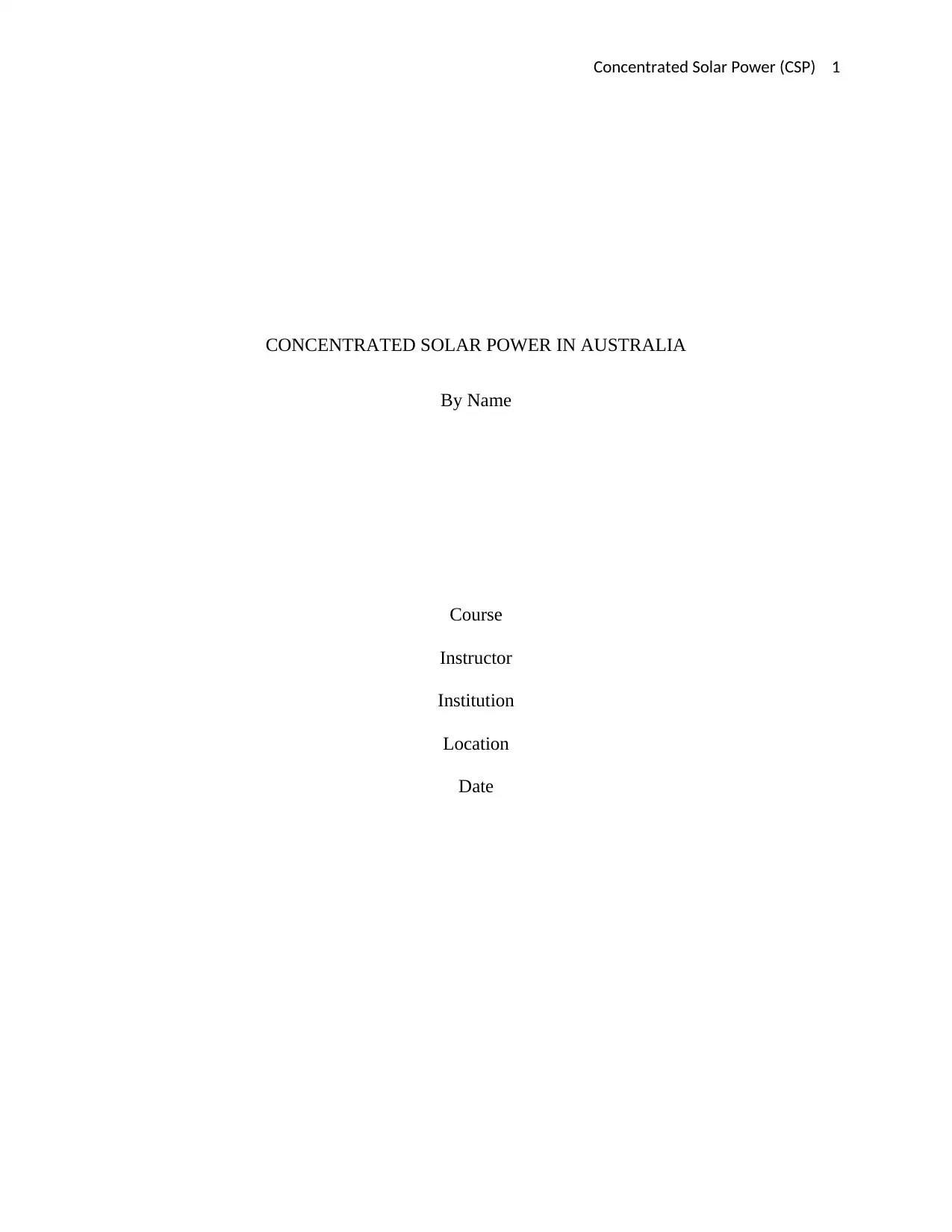
Concentrated Solar Power (CSP) 1
CONCENTRATED SOLAR POWER IN AUSTRALIA
By Name
Course
Instructor
Institution
Location
Date
CONCENTRATED SOLAR POWER IN AUSTRALIA
By Name
Course
Instructor
Institution
Location
Date
Paraphrase This Document
Need a fresh take? Get an instant paraphrase of this document with our AI Paraphraser
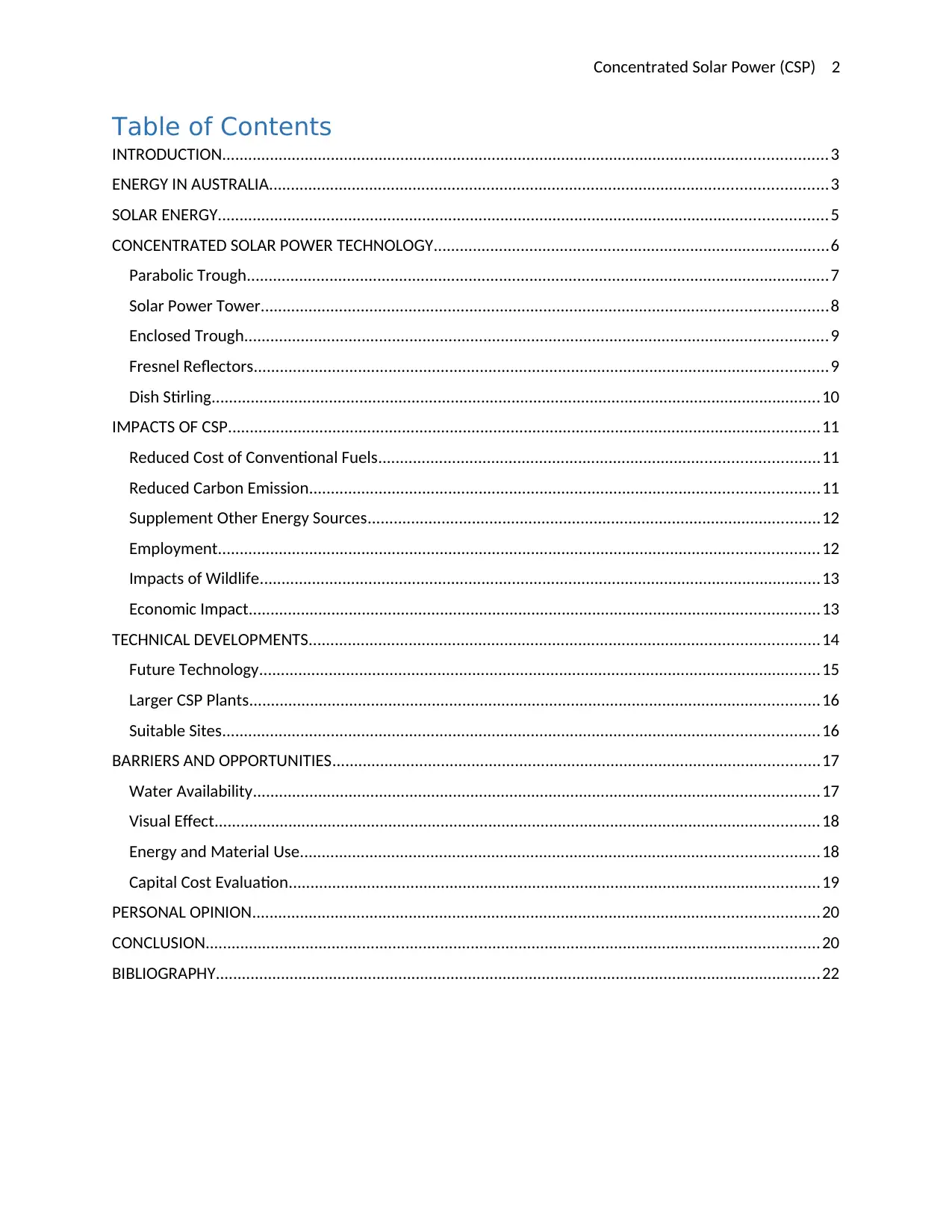
Concentrated Solar Power (CSP) 2
Table of Contents
INTRODUCTION...........................................................................................................................................3
ENERGY IN AUSTRALIA................................................................................................................................3
SOLAR ENERGY............................................................................................................................................5
CONCENTRATED SOLAR POWER TECHNOLOGY...........................................................................................6
Parabolic Trough......................................................................................................................................7
Solar Power Tower..................................................................................................................................8
Enclosed Trough......................................................................................................................................9
Fresnel Reflectors....................................................................................................................................9
Dish Stirling............................................................................................................................................10
IMPACTS OF CSP........................................................................................................................................11
Reduced Cost of Conventional Fuels.....................................................................................................11
Reduced Carbon Emission.....................................................................................................................11
Supplement Other Energy Sources........................................................................................................12
Employment..........................................................................................................................................12
Impacts of Wildlife.................................................................................................................................13
Economic Impact...................................................................................................................................13
TECHNICAL DEVELOPMENTS.....................................................................................................................14
Future Technology.................................................................................................................................15
Larger CSP Plants...................................................................................................................................16
Suitable Sites.........................................................................................................................................16
BARRIERS AND OPPORTUNITIES................................................................................................................17
Water Availability..................................................................................................................................17
Visual Effect...........................................................................................................................................18
Energy and Material Use.......................................................................................................................18
Capital Cost Evaluation..........................................................................................................................19
PERSONAL OPINION..................................................................................................................................20
CONCLUSION.............................................................................................................................................20
BIBLIOGRAPHY...........................................................................................................................................22
Table of Contents
INTRODUCTION...........................................................................................................................................3
ENERGY IN AUSTRALIA................................................................................................................................3
SOLAR ENERGY............................................................................................................................................5
CONCENTRATED SOLAR POWER TECHNOLOGY...........................................................................................6
Parabolic Trough......................................................................................................................................7
Solar Power Tower..................................................................................................................................8
Enclosed Trough......................................................................................................................................9
Fresnel Reflectors....................................................................................................................................9
Dish Stirling............................................................................................................................................10
IMPACTS OF CSP........................................................................................................................................11
Reduced Cost of Conventional Fuels.....................................................................................................11
Reduced Carbon Emission.....................................................................................................................11
Supplement Other Energy Sources........................................................................................................12
Employment..........................................................................................................................................12
Impacts of Wildlife.................................................................................................................................13
Economic Impact...................................................................................................................................13
TECHNICAL DEVELOPMENTS.....................................................................................................................14
Future Technology.................................................................................................................................15
Larger CSP Plants...................................................................................................................................16
Suitable Sites.........................................................................................................................................16
BARRIERS AND OPPORTUNITIES................................................................................................................17
Water Availability..................................................................................................................................17
Visual Effect...........................................................................................................................................18
Energy and Material Use.......................................................................................................................18
Capital Cost Evaluation..........................................................................................................................19
PERSONAL OPINION..................................................................................................................................20
CONCLUSION.............................................................................................................................................20
BIBLIOGRAPHY...........................................................................................................................................22
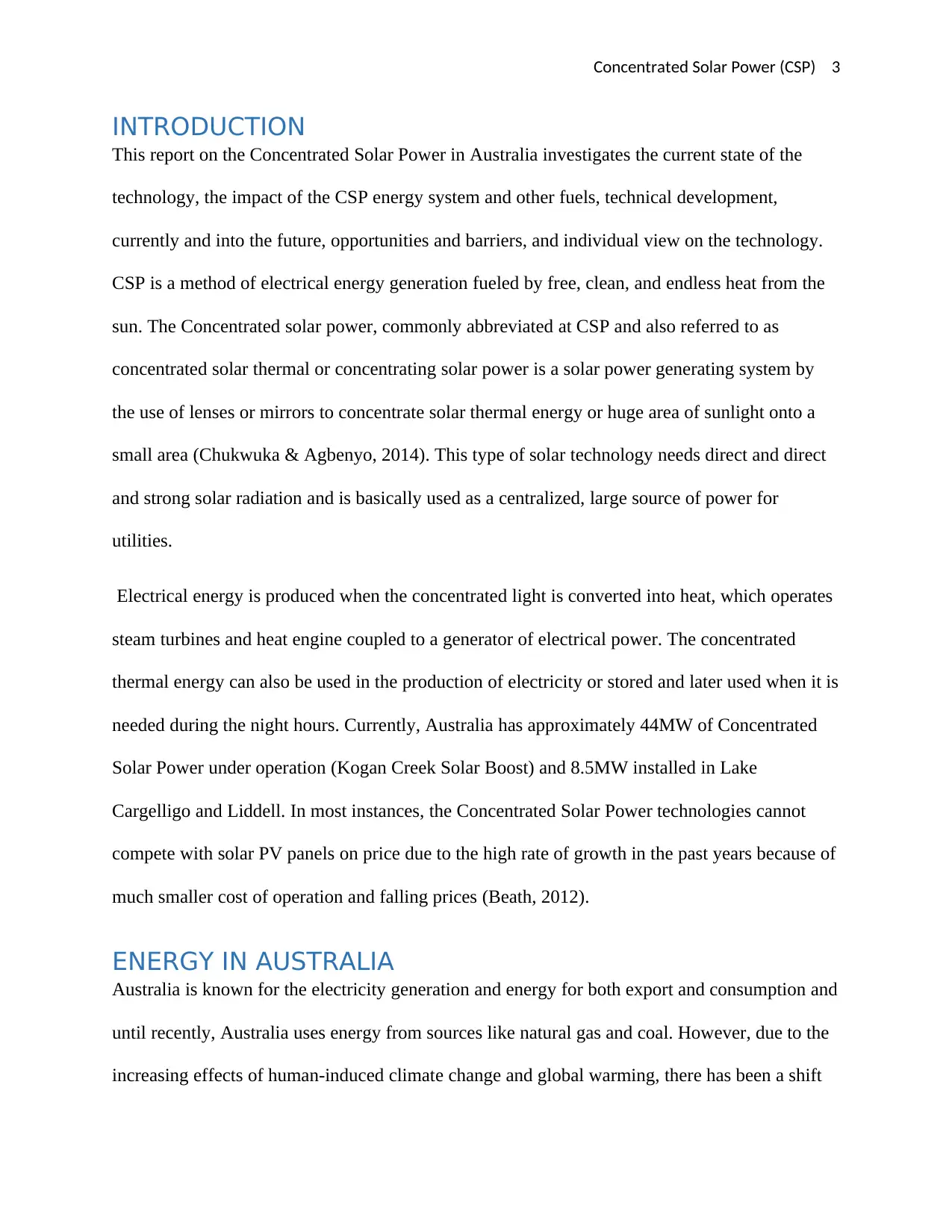
Concentrated Solar Power (CSP) 3
INTRODUCTION
This report on the Concentrated Solar Power in Australia investigates the current state of the
technology, the impact of the CSP energy system and other fuels, technical development,
currently and into the future, opportunities and barriers, and individual view on the technology.
CSP is a method of electrical energy generation fueled by free, clean, and endless heat from the
sun. The Concentrated solar power, commonly abbreviated at CSP and also referred to as
concentrated solar thermal or concentrating solar power is a solar power generating system by
the use of lenses or mirrors to concentrate solar thermal energy or huge area of sunlight onto a
small area (Chukwuka & Agbenyo, 2014). This type of solar technology needs direct and direct
and strong solar radiation and is basically used as a centralized, large source of power for
utilities.
Electrical energy is produced when the concentrated light is converted into heat, which operates
steam turbines and heat engine coupled to a generator of electrical power. The concentrated
thermal energy can also be used in the production of electricity or stored and later used when it is
needed during the night hours. Currently, Australia has approximately 44MW of Concentrated
Solar Power under operation (Kogan Creek Solar Boost) and 8.5MW installed in Lake
Cargelligo and Liddell. In most instances, the Concentrated Solar Power technologies cannot
compete with solar PV panels on price due to the high rate of growth in the past years because of
much smaller cost of operation and falling prices (Beath, 2012).
ENERGY IN AUSTRALIA
Australia is known for the electricity generation and energy for both export and consumption and
until recently, Australia uses energy from sources like natural gas and coal. However, due to the
increasing effects of human-induced climate change and global warming, there has been a shift
INTRODUCTION
This report on the Concentrated Solar Power in Australia investigates the current state of the
technology, the impact of the CSP energy system and other fuels, technical development,
currently and into the future, opportunities and barriers, and individual view on the technology.
CSP is a method of electrical energy generation fueled by free, clean, and endless heat from the
sun. The Concentrated solar power, commonly abbreviated at CSP and also referred to as
concentrated solar thermal or concentrating solar power is a solar power generating system by
the use of lenses or mirrors to concentrate solar thermal energy or huge area of sunlight onto a
small area (Chukwuka & Agbenyo, 2014). This type of solar technology needs direct and direct
and strong solar radiation and is basically used as a centralized, large source of power for
utilities.
Electrical energy is produced when the concentrated light is converted into heat, which operates
steam turbines and heat engine coupled to a generator of electrical power. The concentrated
thermal energy can also be used in the production of electricity or stored and later used when it is
needed during the night hours. Currently, Australia has approximately 44MW of Concentrated
Solar Power under operation (Kogan Creek Solar Boost) and 8.5MW installed in Lake
Cargelligo and Liddell. In most instances, the Concentrated Solar Power technologies cannot
compete with solar PV panels on price due to the high rate of growth in the past years because of
much smaller cost of operation and falling prices (Beath, 2012).
ENERGY IN AUSTRALIA
Australia is known for the electricity generation and energy for both export and consumption and
until recently, Australia uses energy from sources like natural gas and coal. However, due to the
increasing effects of human-induced climate change and global warming, there has been a shift
⊘ This is a preview!⊘
Do you want full access?
Subscribe today to unlock all pages.

Trusted by 1+ million students worldwide
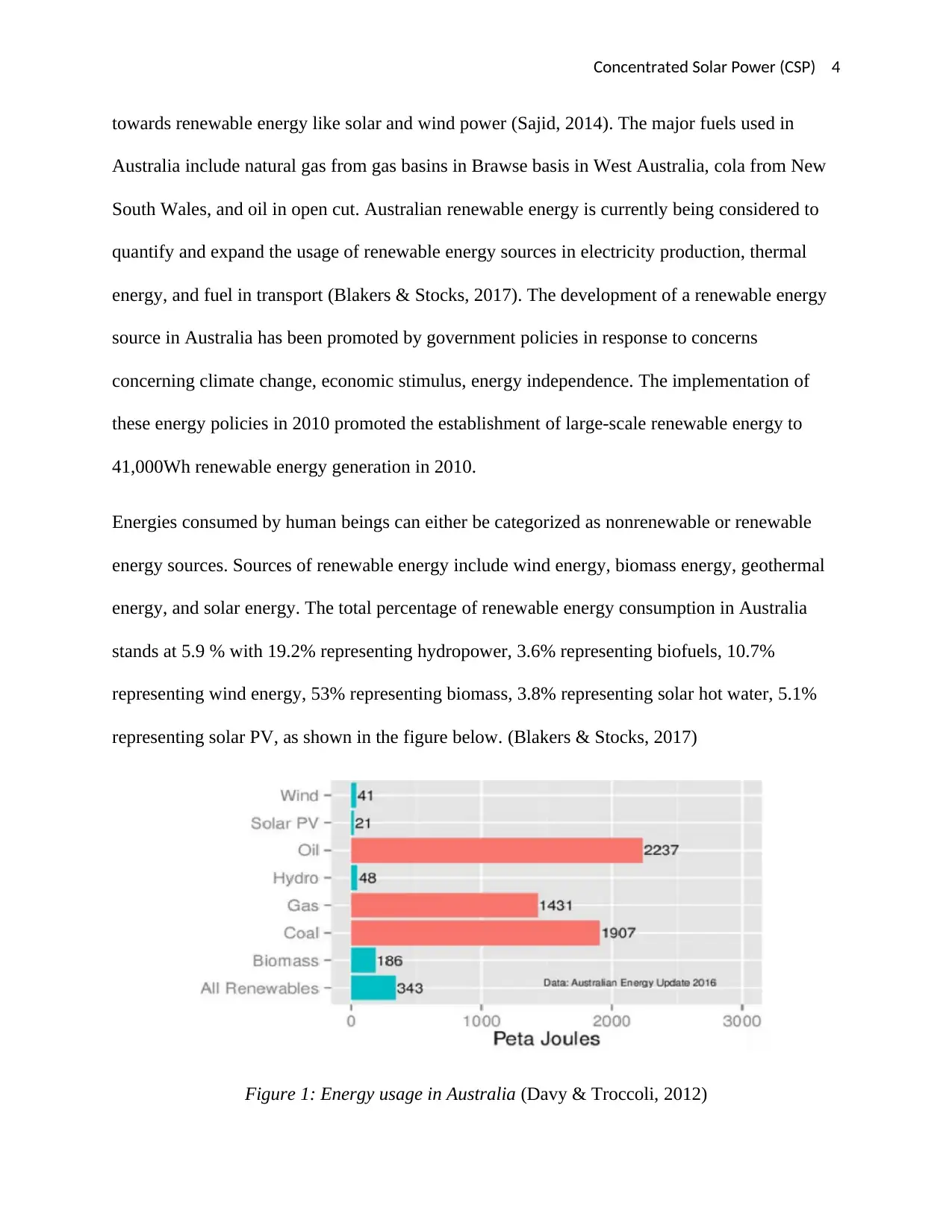
Concentrated Solar Power (CSP) 4
towards renewable energy like solar and wind power (Sajid, 2014). The major fuels used in
Australia include natural gas from gas basins in Brawse basis in West Australia, cola from New
South Wales, and oil in open cut. Australian renewable energy is currently being considered to
quantify and expand the usage of renewable energy sources in electricity production, thermal
energy, and fuel in transport (Blakers & Stocks, 2017). The development of a renewable energy
source in Australia has been promoted by government policies in response to concerns
concerning climate change, economic stimulus, energy independence. The implementation of
these energy policies in 2010 promoted the establishment of large-scale renewable energy to
41,000Wh renewable energy generation in 2010.
Energies consumed by human beings can either be categorized as nonrenewable or renewable
energy sources. Sources of renewable energy include wind energy, biomass energy, geothermal
energy, and solar energy. The total percentage of renewable energy consumption in Australia
stands at 5.9 % with 19.2% representing hydropower, 3.6% representing biofuels, 10.7%
representing wind energy, 53% representing biomass, 3.8% representing solar hot water, 5.1%
representing solar PV, as shown in the figure below. (Blakers & Stocks, 2017)
Figure 1: Energy usage in Australia (Davy & Troccoli, 2012)
towards renewable energy like solar and wind power (Sajid, 2014). The major fuels used in
Australia include natural gas from gas basins in Brawse basis in West Australia, cola from New
South Wales, and oil in open cut. Australian renewable energy is currently being considered to
quantify and expand the usage of renewable energy sources in electricity production, thermal
energy, and fuel in transport (Blakers & Stocks, 2017). The development of a renewable energy
source in Australia has been promoted by government policies in response to concerns
concerning climate change, economic stimulus, energy independence. The implementation of
these energy policies in 2010 promoted the establishment of large-scale renewable energy to
41,000Wh renewable energy generation in 2010.
Energies consumed by human beings can either be categorized as nonrenewable or renewable
energy sources. Sources of renewable energy include wind energy, biomass energy, geothermal
energy, and solar energy. The total percentage of renewable energy consumption in Australia
stands at 5.9 % with 19.2% representing hydropower, 3.6% representing biofuels, 10.7%
representing wind energy, 53% representing biomass, 3.8% representing solar hot water, 5.1%
representing solar PV, as shown in the figure below. (Blakers & Stocks, 2017)
Figure 1: Energy usage in Australia (Davy & Troccoli, 2012)
Paraphrase This Document
Need a fresh take? Get an instant paraphrase of this document with our AI Paraphraser
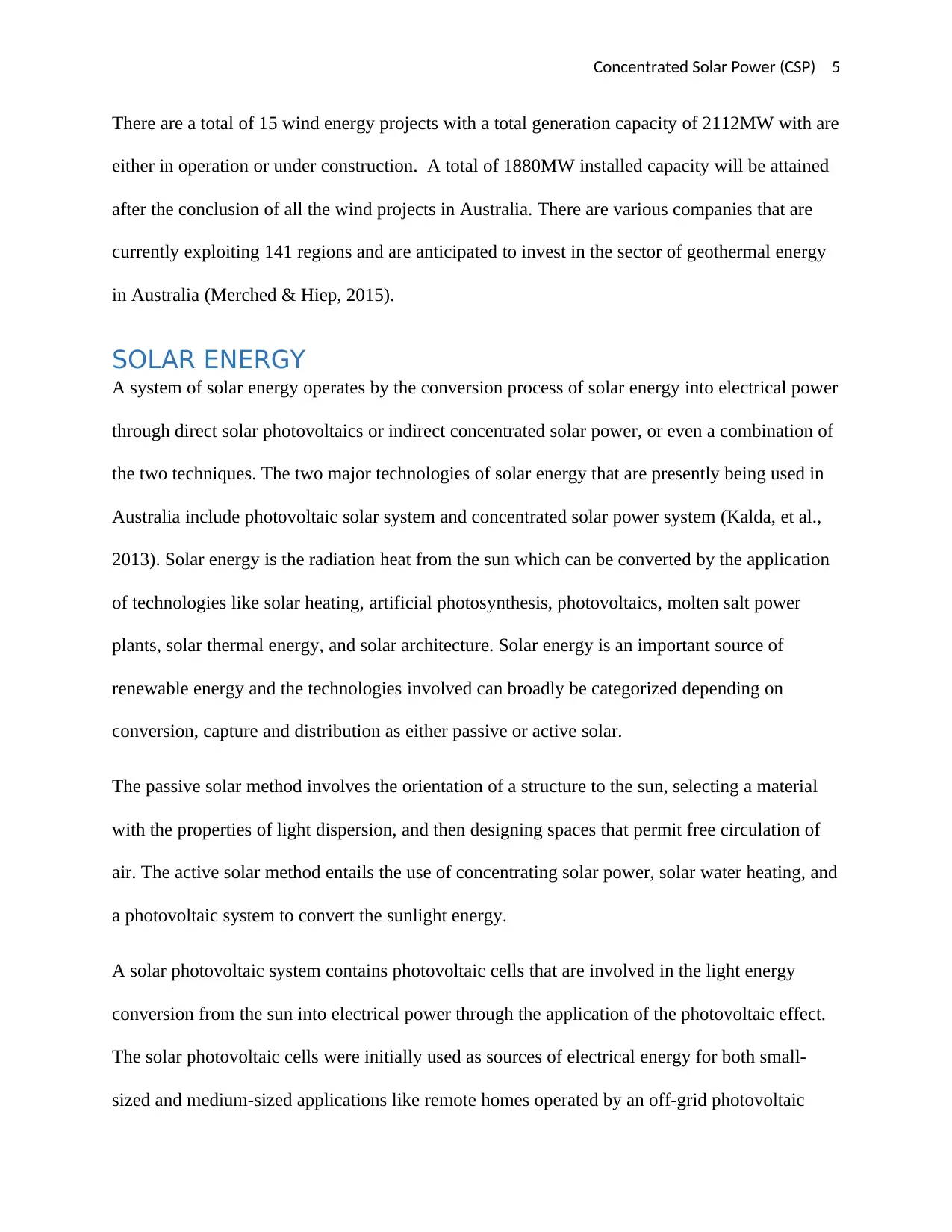
Concentrated Solar Power (CSP) 5
There are a total of 15 wind energy projects with a total generation capacity of 2112MW with are
either in operation or under construction. A total of 1880MW installed capacity will be attained
after the conclusion of all the wind projects in Australia. There are various companies that are
currently exploiting 141 regions and are anticipated to invest in the sector of geothermal energy
in Australia (Merched & Hiep, 2015).
SOLAR ENERGY
A system of solar energy operates by the conversion process of solar energy into electrical power
through direct solar photovoltaics or indirect concentrated solar power, or even a combination of
the two techniques. The two major technologies of solar energy that are presently being used in
Australia include photovoltaic solar system and concentrated solar power system (Kalda, et al.,
2013). Solar energy is the radiation heat from the sun which can be converted by the application
of technologies like solar heating, artificial photosynthesis, photovoltaics, molten salt power
plants, solar thermal energy, and solar architecture. Solar energy is an important source of
renewable energy and the technologies involved can broadly be categorized depending on
conversion, capture and distribution as either passive or active solar.
The passive solar method involves the orientation of a structure to the sun, selecting a material
with the properties of light dispersion, and then designing spaces that permit free circulation of
air. The active solar method entails the use of concentrating solar power, solar water heating, and
a photovoltaic system to convert the sunlight energy.
A solar photovoltaic system contains photovoltaic cells that are involved in the light energy
conversion from the sun into electrical power through the application of the photovoltaic effect.
The solar photovoltaic cells were initially used as sources of electrical energy for both small-
sized and medium-sized applications like remote homes operated by an off-grid photovoltaic
There are a total of 15 wind energy projects with a total generation capacity of 2112MW with are
either in operation or under construction. A total of 1880MW installed capacity will be attained
after the conclusion of all the wind projects in Australia. There are various companies that are
currently exploiting 141 regions and are anticipated to invest in the sector of geothermal energy
in Australia (Merched & Hiep, 2015).
SOLAR ENERGY
A system of solar energy operates by the conversion process of solar energy into electrical power
through direct solar photovoltaics or indirect concentrated solar power, or even a combination of
the two techniques. The two major technologies of solar energy that are presently being used in
Australia include photovoltaic solar system and concentrated solar power system (Kalda, et al.,
2013). Solar energy is the radiation heat from the sun which can be converted by the application
of technologies like solar heating, artificial photosynthesis, photovoltaics, molten salt power
plants, solar thermal energy, and solar architecture. Solar energy is an important source of
renewable energy and the technologies involved can broadly be categorized depending on
conversion, capture and distribution as either passive or active solar.
The passive solar method involves the orientation of a structure to the sun, selecting a material
with the properties of light dispersion, and then designing spaces that permit free circulation of
air. The active solar method entails the use of concentrating solar power, solar water heating, and
a photovoltaic system to convert the sunlight energy.
A solar photovoltaic system contains photovoltaic cells that are involved in the light energy
conversion from the sun into electrical power through the application of the photovoltaic effect.
The solar photovoltaic cells were initially used as sources of electrical energy for both small-
sized and medium-sized applications like remote homes operated by an off-grid photovoltaic
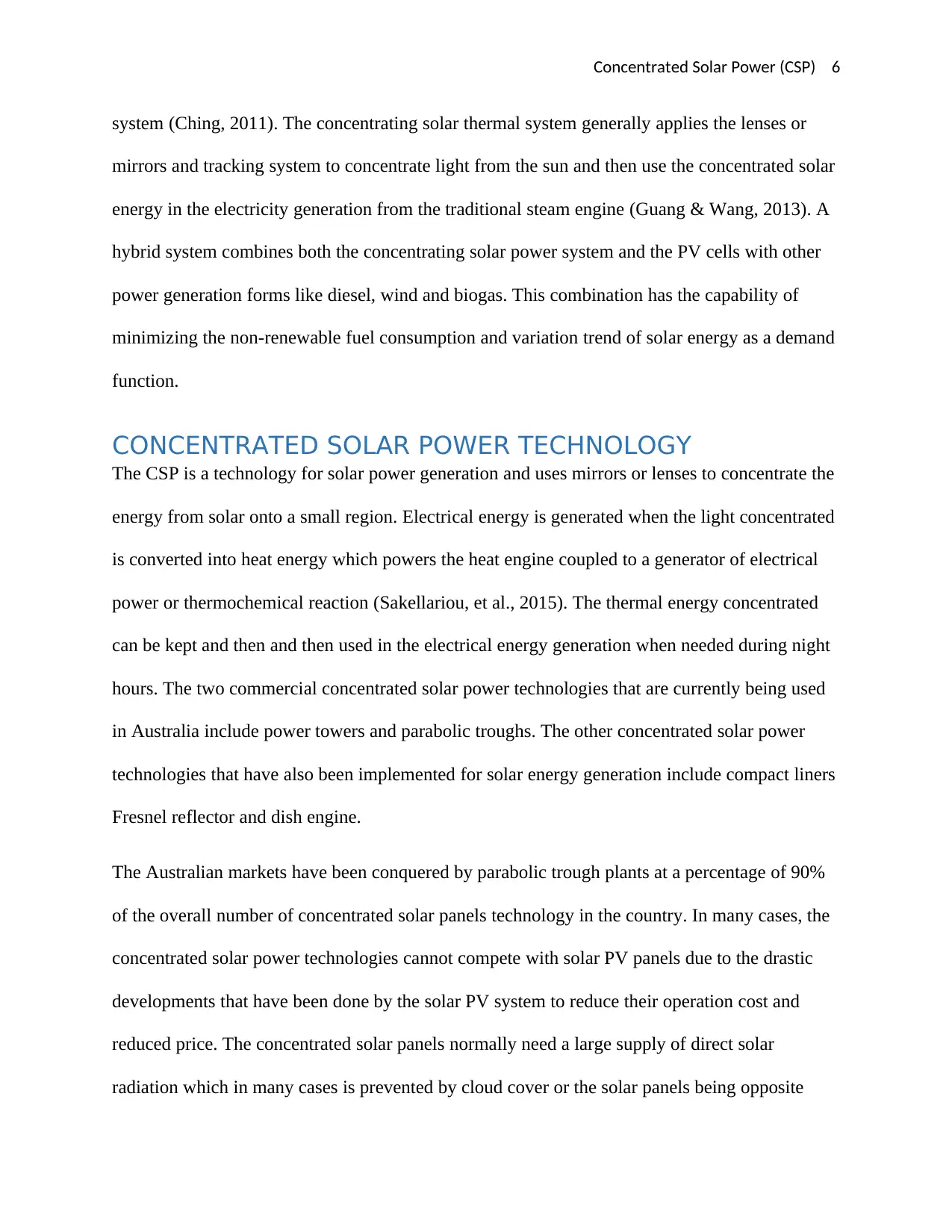
Concentrated Solar Power (CSP) 6
system (Ching, 2011). The concentrating solar thermal system generally applies the lenses or
mirrors and tracking system to concentrate light from the sun and then use the concentrated solar
energy in the electricity generation from the traditional steam engine (Guang & Wang, 2013). A
hybrid system combines both the concentrating solar power system and the PV cells with other
power generation forms like diesel, wind and biogas. This combination has the capability of
minimizing the non-renewable fuel consumption and variation trend of solar energy as a demand
function.
CONCENTRATED SOLAR POWER TECHNOLOGY
The CSP is a technology for solar power generation and uses mirrors or lenses to concentrate the
energy from solar onto a small region. Electrical energy is generated when the light concentrated
is converted into heat energy which powers the heat engine coupled to a generator of electrical
power or thermochemical reaction (Sakellariou, et al., 2015). The thermal energy concentrated
can be kept and then and then used in the electrical energy generation when needed during night
hours. The two commercial concentrated solar power technologies that are currently being used
in Australia include power towers and parabolic troughs. The other concentrated solar power
technologies that have also been implemented for solar energy generation include compact liners
Fresnel reflector and dish engine.
The Australian markets have been conquered by parabolic trough plants at a percentage of 90%
of the overall number of concentrated solar panels technology in the country. In many cases, the
concentrated solar power technologies cannot compete with solar PV panels due to the drastic
developments that have been done by the solar PV system to reduce their operation cost and
reduced price. The concentrated solar panels normally need a large supply of direct solar
radiation which in many cases is prevented by cloud cover or the solar panels being opposite
system (Ching, 2011). The concentrating solar thermal system generally applies the lenses or
mirrors and tracking system to concentrate light from the sun and then use the concentrated solar
energy in the electricity generation from the traditional steam engine (Guang & Wang, 2013). A
hybrid system combines both the concentrating solar power system and the PV cells with other
power generation forms like diesel, wind and biogas. This combination has the capability of
minimizing the non-renewable fuel consumption and variation trend of solar energy as a demand
function.
CONCENTRATED SOLAR POWER TECHNOLOGY
The CSP is a technology for solar power generation and uses mirrors or lenses to concentrate the
energy from solar onto a small region. Electrical energy is generated when the light concentrated
is converted into heat energy which powers the heat engine coupled to a generator of electrical
power or thermochemical reaction (Sakellariou, et al., 2015). The thermal energy concentrated
can be kept and then and then used in the electrical energy generation when needed during night
hours. The two commercial concentrated solar power technologies that are currently being used
in Australia include power towers and parabolic troughs. The other concentrated solar power
technologies that have also been implemented for solar energy generation include compact liners
Fresnel reflector and dish engine.
The Australian markets have been conquered by parabolic trough plants at a percentage of 90%
of the overall number of concentrated solar panels technology in the country. In many cases, the
concentrated solar power technologies cannot compete with solar PV panels due to the drastic
developments that have been done by the solar PV system to reduce their operation cost and
reduced price. The concentrated solar panels normally need a large supply of direct solar
radiation which in many cases is prevented by cloud cover or the solar panels being opposite
⊘ This is a preview!⊘
Do you want full access?
Subscribe today to unlock all pages.

Trusted by 1+ million students worldwide
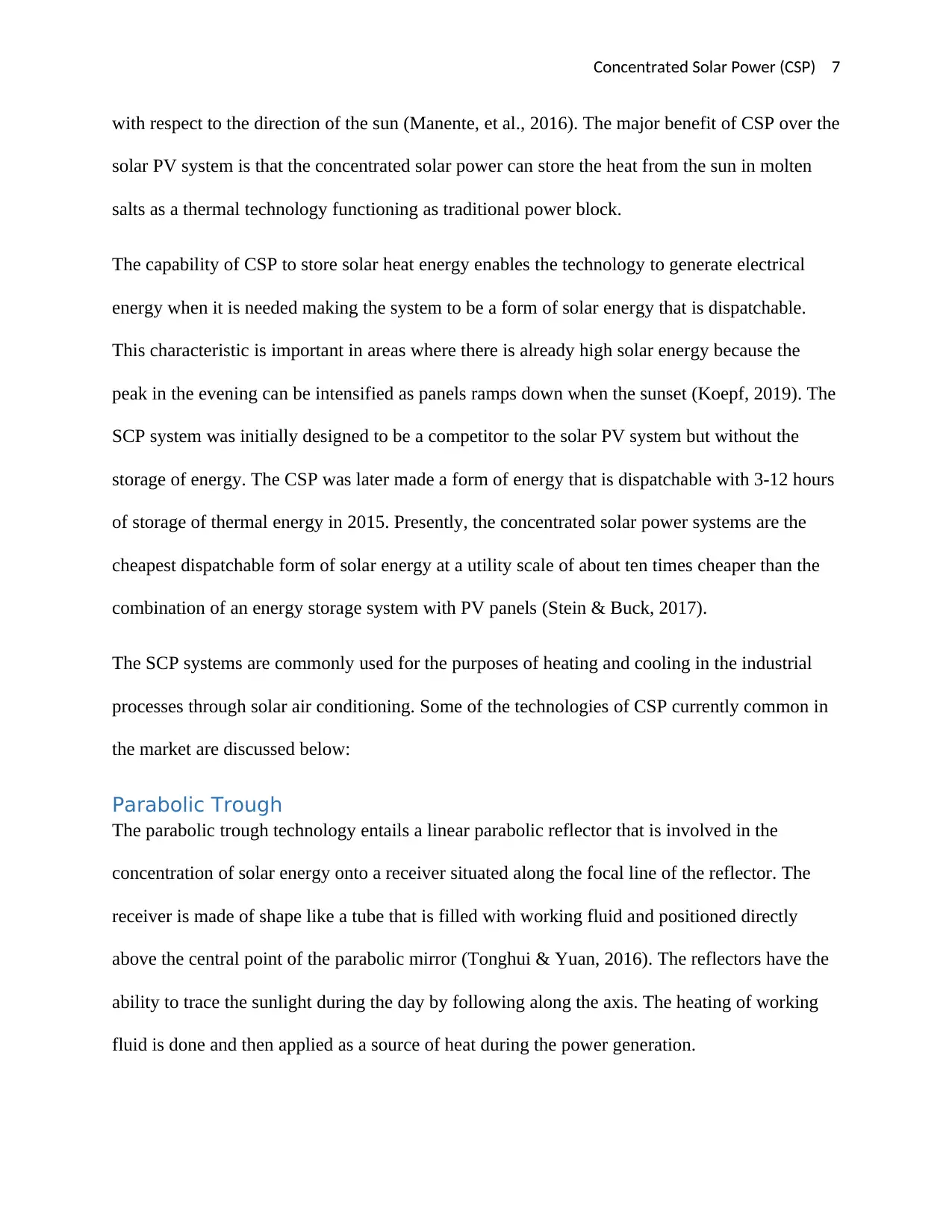
Concentrated Solar Power (CSP) 7
with respect to the direction of the sun (Manente, et al., 2016). The major benefit of CSP over the
solar PV system is that the concentrated solar power can store the heat from the sun in molten
salts as a thermal technology functioning as traditional power block.
The capability of CSP to store solar heat energy enables the technology to generate electrical
energy when it is needed making the system to be a form of solar energy that is dispatchable.
This characteristic is important in areas where there is already high solar energy because the
peak in the evening can be intensified as panels ramps down when the sunset (Koepf, 2019). The
SCP system was initially designed to be a competitor to the solar PV system but without the
storage of energy. The CSP was later made a form of energy that is dispatchable with 3-12 hours
of storage of thermal energy in 2015. Presently, the concentrated solar power systems are the
cheapest dispatchable form of solar energy at a utility scale of about ten times cheaper than the
combination of an energy storage system with PV panels (Stein & Buck, 2017).
The SCP systems are commonly used for the purposes of heating and cooling in the industrial
processes through solar air conditioning. Some of the technologies of CSP currently common in
the market are discussed below:
Parabolic Trough
The parabolic trough technology entails a linear parabolic reflector that is involved in the
concentration of solar energy onto a receiver situated along the focal line of the reflector. The
receiver is made of shape like a tube that is filled with working fluid and positioned directly
above the central point of the parabolic mirror (Tonghui & Yuan, 2016). The reflectors have the
ability to trace the sunlight during the day by following along the axis. The heating of working
fluid is done and then applied as a source of heat during the power generation.
with respect to the direction of the sun (Manente, et al., 2016). The major benefit of CSP over the
solar PV system is that the concentrated solar power can store the heat from the sun in molten
salts as a thermal technology functioning as traditional power block.
The capability of CSP to store solar heat energy enables the technology to generate electrical
energy when it is needed making the system to be a form of solar energy that is dispatchable.
This characteristic is important in areas where there is already high solar energy because the
peak in the evening can be intensified as panels ramps down when the sunset (Koepf, 2019). The
SCP system was initially designed to be a competitor to the solar PV system but without the
storage of energy. The CSP was later made a form of energy that is dispatchable with 3-12 hours
of storage of thermal energy in 2015. Presently, the concentrated solar power systems are the
cheapest dispatchable form of solar energy at a utility scale of about ten times cheaper than the
combination of an energy storage system with PV panels (Stein & Buck, 2017).
The SCP systems are commonly used for the purposes of heating and cooling in the industrial
processes through solar air conditioning. Some of the technologies of CSP currently common in
the market are discussed below:
Parabolic Trough
The parabolic trough technology entails a linear parabolic reflector that is involved in the
concentration of solar energy onto a receiver situated along the focal line of the reflector. The
receiver is made of shape like a tube that is filled with working fluid and positioned directly
above the central point of the parabolic mirror (Tonghui & Yuan, 2016). The reflectors have the
ability to trace the sunlight during the day by following along the axis. The heating of working
fluid is done and then applied as a source of heat during the power generation.
Paraphrase This Document
Need a fresh take? Get an instant paraphrase of this document with our AI Paraphraser
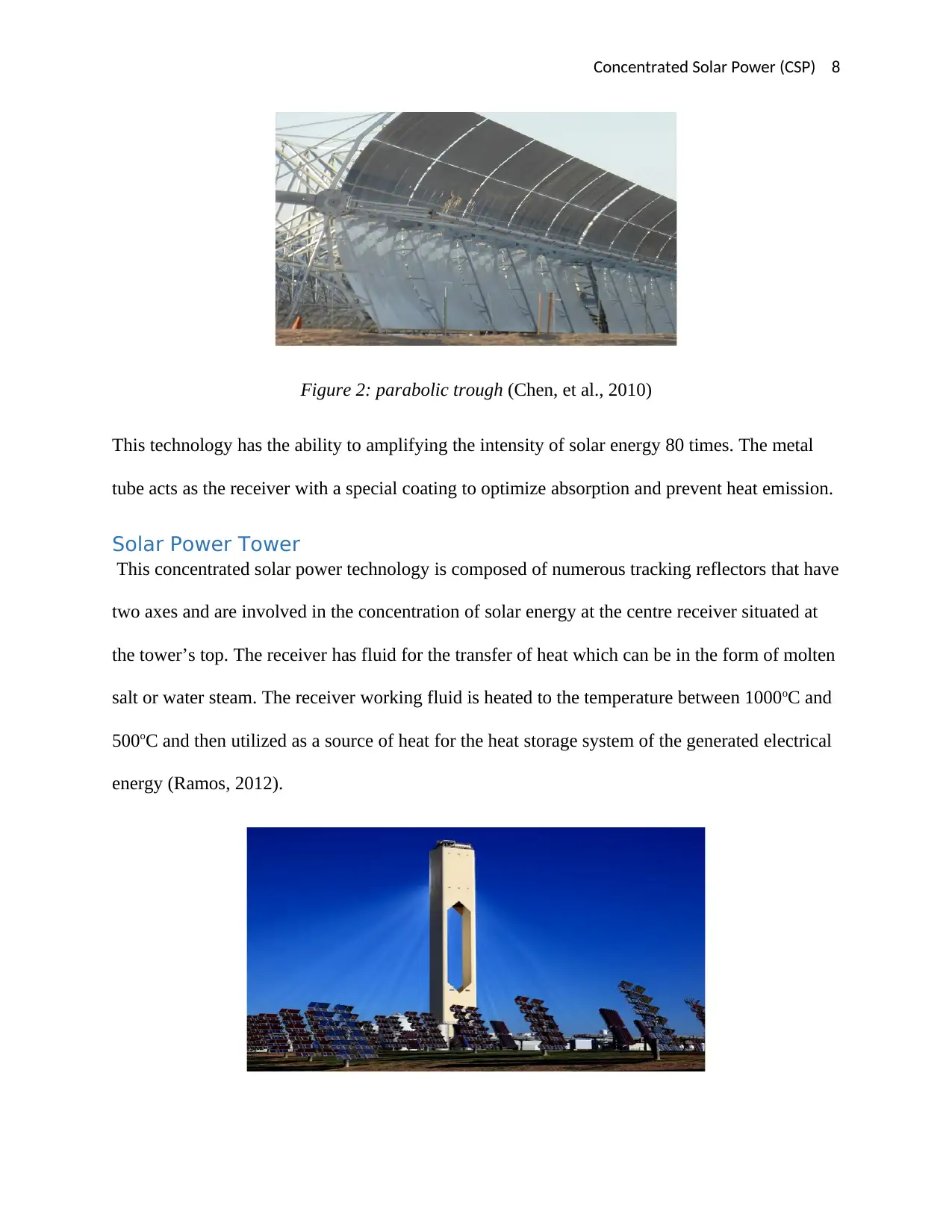
Concentrated Solar Power (CSP) 8
Figure 2: parabolic trough (Chen, et al., 2010)
This technology has the ability to amplifying the intensity of solar energy 80 times. The metal
tube acts as the receiver with a special coating to optimize absorption and prevent heat emission.
Solar Power Tower
This concentrated solar power technology is composed of numerous tracking reflectors that have
two axes and are involved in the concentration of solar energy at the centre receiver situated at
the tower’s top. The receiver has fluid for the transfer of heat which can be in the form of molten
salt or water steam. The receiver working fluid is heated to the temperature between 1000oC and
500oC and then utilized as a source of heat for the heat storage system of the generated electrical
energy (Ramos, 2012).
Figure 2: parabolic trough (Chen, et al., 2010)
This technology has the ability to amplifying the intensity of solar energy 80 times. The metal
tube acts as the receiver with a special coating to optimize absorption and prevent heat emission.
Solar Power Tower
This concentrated solar power technology is composed of numerous tracking reflectors that have
two axes and are involved in the concentration of solar energy at the centre receiver situated at
the tower’s top. The receiver has fluid for the transfer of heat which can be in the form of molten
salt or water steam. The receiver working fluid is heated to the temperature between 1000oC and
500oC and then utilized as a source of heat for the heat storage system of the generated electrical
energy (Ramos, 2012).
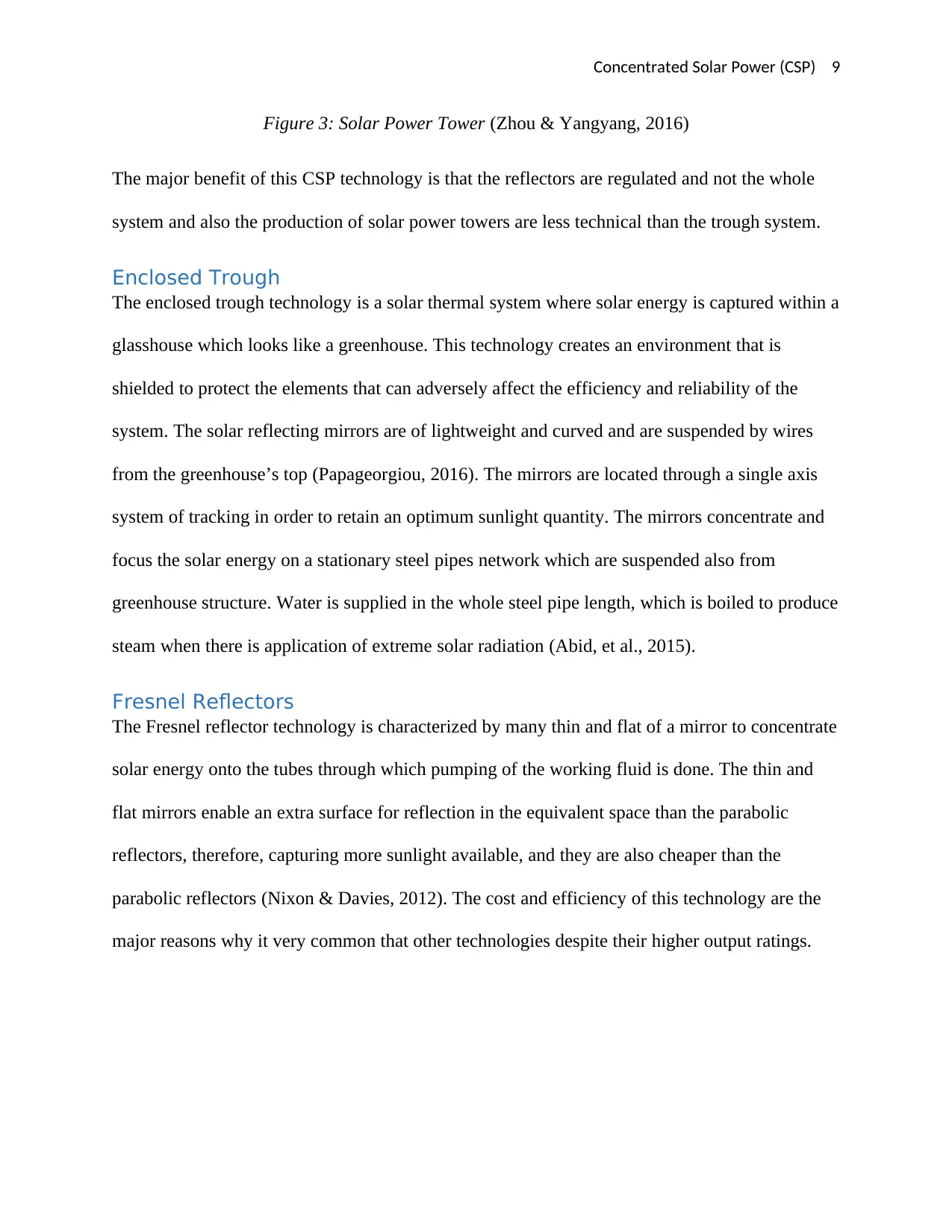
Concentrated Solar Power (CSP) 9
Figure 3: Solar Power Tower (Zhou & Yangyang, 2016)
The major benefit of this CSP technology is that the reflectors are regulated and not the whole
system and also the production of solar power towers are less technical than the trough system.
Enclosed Trough
The enclosed trough technology is a solar thermal system where solar energy is captured within a
glasshouse which looks like a greenhouse. This technology creates an environment that is
shielded to protect the elements that can adversely affect the efficiency and reliability of the
system. The solar reflecting mirrors are of lightweight and curved and are suspended by wires
from the greenhouse’s top (Papageorgiou, 2016). The mirrors are located through a single axis
system of tracking in order to retain an optimum sunlight quantity. The mirrors concentrate and
focus the solar energy on a stationary steel pipes network which are suspended also from
greenhouse structure. Water is supplied in the whole steel pipe length, which is boiled to produce
steam when there is application of extreme solar radiation (Abid, et al., 2015).
Fresnel Reflectors
The Fresnel reflector technology is characterized by many thin and flat of a mirror to concentrate
solar energy onto the tubes through which pumping of the working fluid is done. The thin and
flat mirrors enable an extra surface for reflection in the equivalent space than the parabolic
reflectors, therefore, capturing more sunlight available, and they are also cheaper than the
parabolic reflectors (Nixon & Davies, 2012). The cost and efficiency of this technology are the
major reasons why it very common that other technologies despite their higher output ratings.
Figure 3: Solar Power Tower (Zhou & Yangyang, 2016)
The major benefit of this CSP technology is that the reflectors are regulated and not the whole
system and also the production of solar power towers are less technical than the trough system.
Enclosed Trough
The enclosed trough technology is a solar thermal system where solar energy is captured within a
glasshouse which looks like a greenhouse. This technology creates an environment that is
shielded to protect the elements that can adversely affect the efficiency and reliability of the
system. The solar reflecting mirrors are of lightweight and curved and are suspended by wires
from the greenhouse’s top (Papageorgiou, 2016). The mirrors are located through a single axis
system of tracking in order to retain an optimum sunlight quantity. The mirrors concentrate and
focus the solar energy on a stationary steel pipes network which are suspended also from
greenhouse structure. Water is supplied in the whole steel pipe length, which is boiled to produce
steam when there is application of extreme solar radiation (Abid, et al., 2015).
Fresnel Reflectors
The Fresnel reflector technology is characterized by many thin and flat of a mirror to concentrate
solar energy onto the tubes through which pumping of the working fluid is done. The thin and
flat mirrors enable an extra surface for reflection in the equivalent space than the parabolic
reflectors, therefore, capturing more sunlight available, and they are also cheaper than the
parabolic reflectors (Nixon & Davies, 2012). The cost and efficiency of this technology are the
major reasons why it very common that other technologies despite their higher output ratings.
⊘ This is a preview!⊘
Do you want full access?
Subscribe today to unlock all pages.

Trusted by 1+ million students worldwide
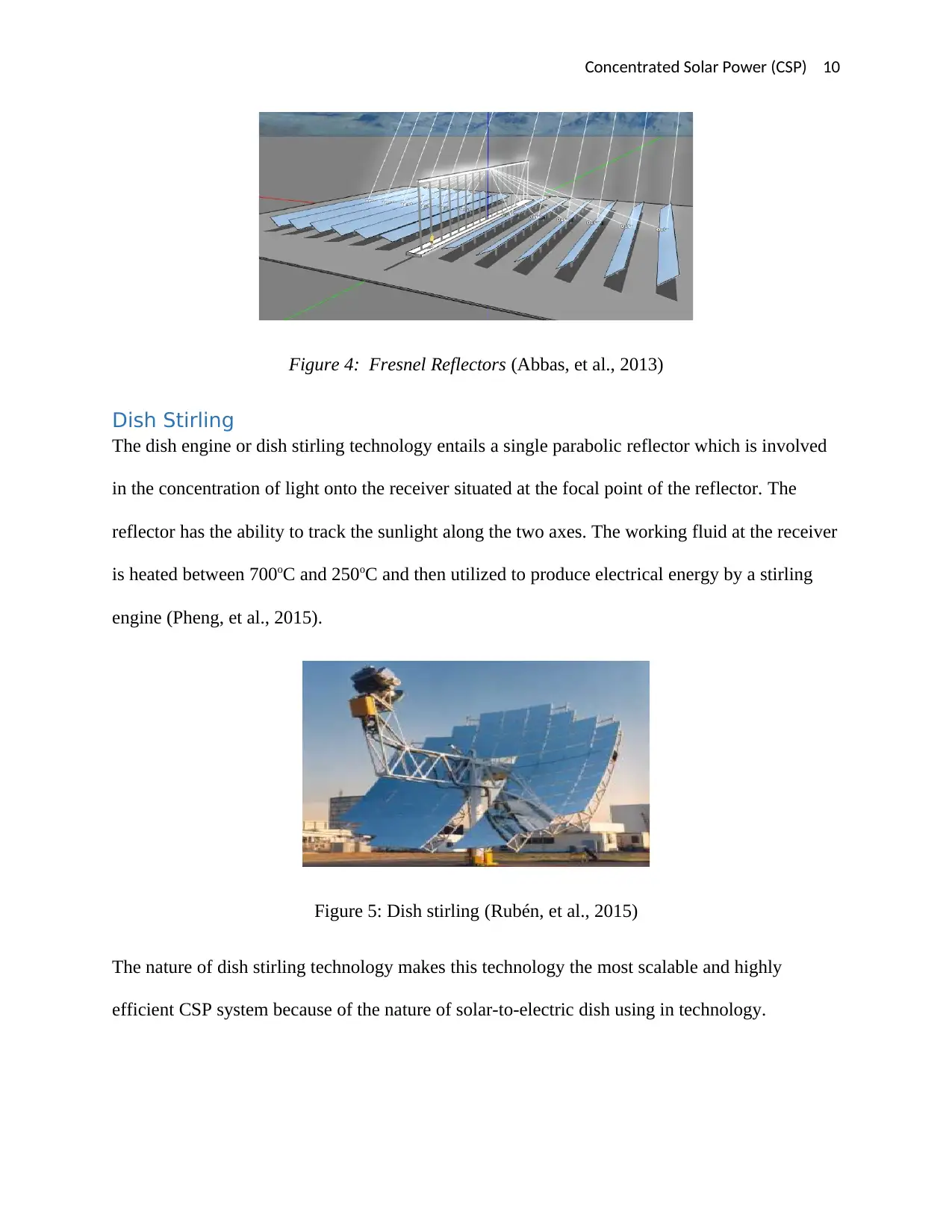
Concentrated Solar Power (CSP) 10
Figure 4: Fresnel Reflectors (Abbas, et al., 2013)
Dish Stirling
The dish engine or dish stirling technology entails a single parabolic reflector which is involved
in the concentration of light onto the receiver situated at the focal point of the reflector. The
reflector has the ability to track the sunlight along the two axes. The working fluid at the receiver
is heated between 700oC and 250oC and then utilized to produce electrical energy by a stirling
engine (Pheng, et al., 2015).
Figure 5: Dish stirling (Rubén, et al., 2015)
The nature of dish stirling technology makes this technology the most scalable and highly
efficient CSP system because of the nature of solar-to-electric dish using in technology.
Figure 4: Fresnel Reflectors (Abbas, et al., 2013)
Dish Stirling
The dish engine or dish stirling technology entails a single parabolic reflector which is involved
in the concentration of light onto the receiver situated at the focal point of the reflector. The
reflector has the ability to track the sunlight along the two axes. The working fluid at the receiver
is heated between 700oC and 250oC and then utilized to produce electrical energy by a stirling
engine (Pheng, et al., 2015).
Figure 5: Dish stirling (Rubén, et al., 2015)
The nature of dish stirling technology makes this technology the most scalable and highly
efficient CSP system because of the nature of solar-to-electric dish using in technology.
Paraphrase This Document
Need a fresh take? Get an instant paraphrase of this document with our AI Paraphraser
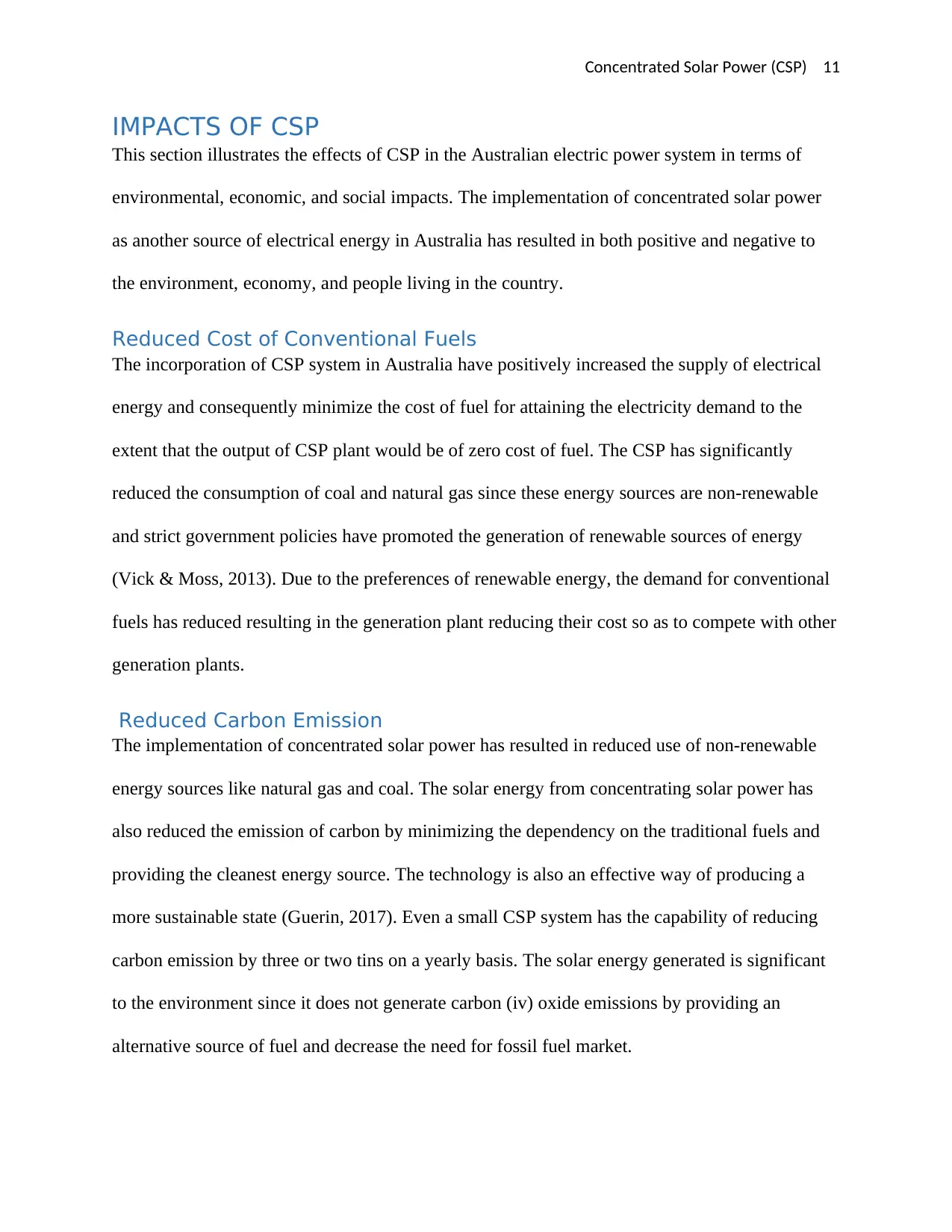
Concentrated Solar Power (CSP) 11
IMPACTS OF CSP
This section illustrates the effects of CSP in the Australian electric power system in terms of
environmental, economic, and social impacts. The implementation of concentrated solar power
as another source of electrical energy in Australia has resulted in both positive and negative to
the environment, economy, and people living in the country.
Reduced Cost of Conventional Fuels
The incorporation of CSP system in Australia have positively increased the supply of electrical
energy and consequently minimize the cost of fuel for attaining the electricity demand to the
extent that the output of CSP plant would be of zero cost of fuel. The CSP has significantly
reduced the consumption of coal and natural gas since these energy sources are non-renewable
and strict government policies have promoted the generation of renewable sources of energy
(Vick & Moss, 2013). Due to the preferences of renewable energy, the demand for conventional
fuels has reduced resulting in the generation plant reducing their cost so as to compete with other
generation plants.
Reduced Carbon Emission
The implementation of concentrated solar power has resulted in reduced use of non-renewable
energy sources like natural gas and coal. The solar energy from concentrating solar power has
also reduced the emission of carbon by minimizing the dependency on the traditional fuels and
providing the cleanest energy source. The technology is also an effective way of producing a
more sustainable state (Guerin, 2017). Even a small CSP system has the capability of reducing
carbon emission by three or two tins on a yearly basis. The solar energy generated is significant
to the environment since it does not generate carbon (iv) oxide emissions by providing an
alternative source of fuel and decrease the need for fossil fuel market.
IMPACTS OF CSP
This section illustrates the effects of CSP in the Australian electric power system in terms of
environmental, economic, and social impacts. The implementation of concentrated solar power
as another source of electrical energy in Australia has resulted in both positive and negative to
the environment, economy, and people living in the country.
Reduced Cost of Conventional Fuels
The incorporation of CSP system in Australia have positively increased the supply of electrical
energy and consequently minimize the cost of fuel for attaining the electricity demand to the
extent that the output of CSP plant would be of zero cost of fuel. The CSP has significantly
reduced the consumption of coal and natural gas since these energy sources are non-renewable
and strict government policies have promoted the generation of renewable sources of energy
(Vick & Moss, 2013). Due to the preferences of renewable energy, the demand for conventional
fuels has reduced resulting in the generation plant reducing their cost so as to compete with other
generation plants.
Reduced Carbon Emission
The implementation of concentrated solar power has resulted in reduced use of non-renewable
energy sources like natural gas and coal. The solar energy from concentrating solar power has
also reduced the emission of carbon by minimizing the dependency on the traditional fuels and
providing the cleanest energy source. The technology is also an effective way of producing a
more sustainable state (Guerin, 2017). Even a small CSP system has the capability of reducing
carbon emission by three or two tins on a yearly basis. The solar energy generated is significant
to the environment since it does not generate carbon (iv) oxide emissions by providing an
alternative source of fuel and decrease the need for fossil fuel market.
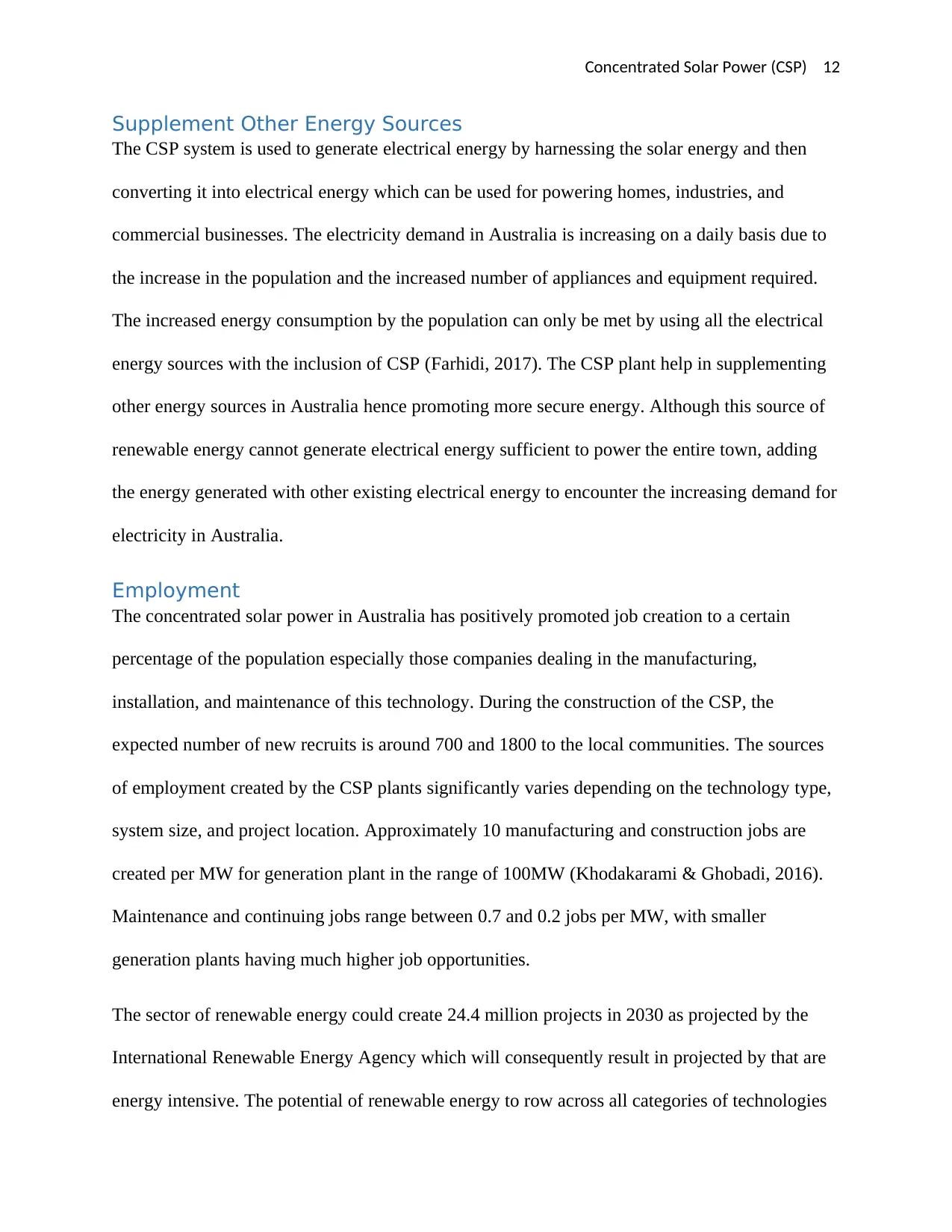
Concentrated Solar Power (CSP) 12
Supplement Other Energy Sources
The CSP system is used to generate electrical energy by harnessing the solar energy and then
converting it into electrical energy which can be used for powering homes, industries, and
commercial businesses. The electricity demand in Australia is increasing on a daily basis due to
the increase in the population and the increased number of appliances and equipment required.
The increased energy consumption by the population can only be met by using all the electrical
energy sources with the inclusion of CSP (Farhidi, 2017). The CSP plant help in supplementing
other energy sources in Australia hence promoting more secure energy. Although this source of
renewable energy cannot generate electrical energy sufficient to power the entire town, adding
the energy generated with other existing electrical energy to encounter the increasing demand for
electricity in Australia.
Employment
The concentrated solar power in Australia has positively promoted job creation to a certain
percentage of the population especially those companies dealing in the manufacturing,
installation, and maintenance of this technology. During the construction of the CSP, the
expected number of new recruits is around 700 and 1800 to the local communities. The sources
of employment created by the CSP plants significantly varies depending on the technology type,
system size, and project location. Approximately 10 manufacturing and construction jobs are
created per MW for generation plant in the range of 100MW (Khodakarami & Ghobadi, 2016).
Maintenance and continuing jobs range between 0.7 and 0.2 jobs per MW, with smaller
generation plants having much higher job opportunities.
The sector of renewable energy could create 24.4 million projects in 2030 as projected by the
International Renewable Energy Agency which will consequently result in projected by that are
energy intensive. The potential of renewable energy to row across all categories of technologies
Supplement Other Energy Sources
The CSP system is used to generate electrical energy by harnessing the solar energy and then
converting it into electrical energy which can be used for powering homes, industries, and
commercial businesses. The electricity demand in Australia is increasing on a daily basis due to
the increase in the population and the increased number of appliances and equipment required.
The increased energy consumption by the population can only be met by using all the electrical
energy sources with the inclusion of CSP (Farhidi, 2017). The CSP plant help in supplementing
other energy sources in Australia hence promoting more secure energy. Although this source of
renewable energy cannot generate electrical energy sufficient to power the entire town, adding
the energy generated with other existing electrical energy to encounter the increasing demand for
electricity in Australia.
Employment
The concentrated solar power in Australia has positively promoted job creation to a certain
percentage of the population especially those companies dealing in the manufacturing,
installation, and maintenance of this technology. During the construction of the CSP, the
expected number of new recruits is around 700 and 1800 to the local communities. The sources
of employment created by the CSP plants significantly varies depending on the technology type,
system size, and project location. Approximately 10 manufacturing and construction jobs are
created per MW for generation plant in the range of 100MW (Khodakarami & Ghobadi, 2016).
Maintenance and continuing jobs range between 0.7 and 0.2 jobs per MW, with smaller
generation plants having much higher job opportunities.
The sector of renewable energy could create 24.4 million projects in 2030 as projected by the
International Renewable Energy Agency which will consequently result in projected by that are
energy intensive. The potential of renewable energy to row across all categories of technologies
⊘ This is a preview!⊘
Do you want full access?
Subscribe today to unlock all pages.

Trusted by 1+ million students worldwide
1 out of 24
Related Documents
Your All-in-One AI-Powered Toolkit for Academic Success.
+13062052269
info@desklib.com
Available 24*7 on WhatsApp / Email
![[object Object]](/_next/static/media/star-bottom.7253800d.svg)
Unlock your academic potential
Copyright © 2020–2025 A2Z Services. All Rights Reserved. Developed and managed by ZUCOL.




